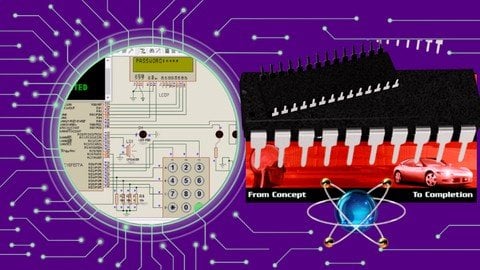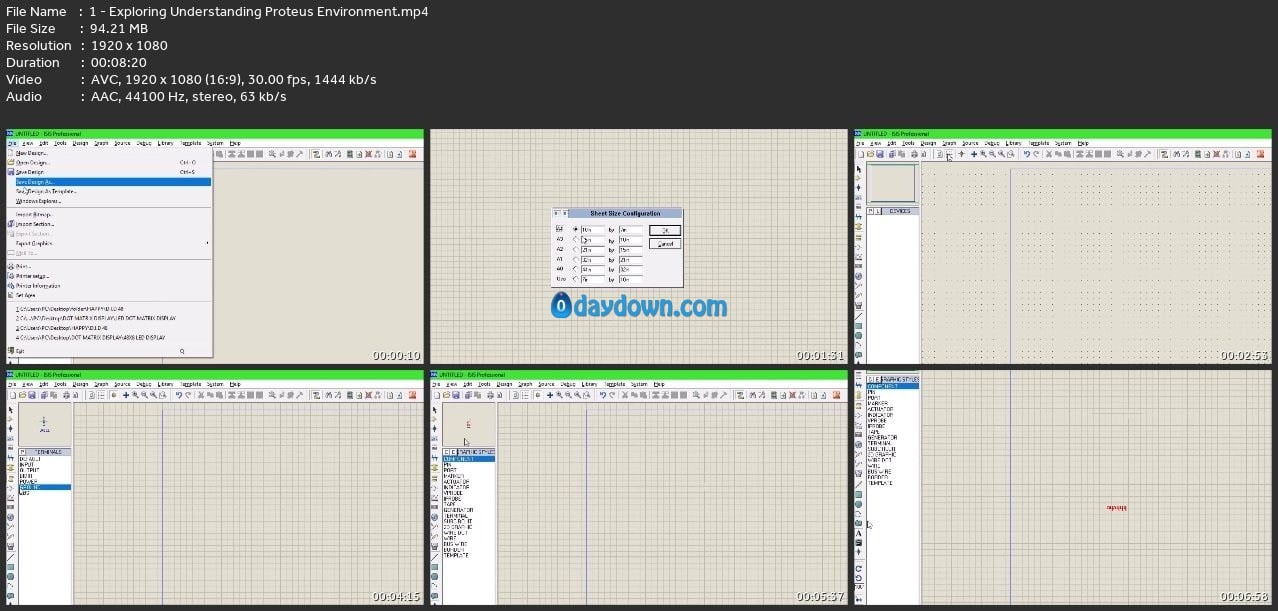
Published 8/2024
MP4 | Video: h264, 1920×1080 | Audio: AAC, 44.1 KHz
Language: English | Size: 2.04 GB | Duration: 3h 13m
Simulations to Real-World Solutions: Mastering Proteus Circuit Design and PIC Microcontroller Programming with Mikro C
What you’ll learn
Exploring & Understanding Proteus Environment: Get familiar with the Proteus interface, its tools, and how to navigate the workspace.
How To Pick Components From Proteus: Learn how to select the right components from the Proteus library for your circuit designs.
Your First Circuit Design In Proteus: Create your first simple circuit in Proteus, understanding the basics of circuit layout.
LED Control With Button In Proteus: Design a circuit to control an LED with a button, a fundamental skill in electronics.
How To Save Your Project In Proteus: Learn to save your work properly to ensure your designs are preserved and easily accessible
Configuring NPN And PNP Transistor: Understand the configuration of NPN and PNP transistors for circuit designs.
Configuring A Relay With NPN Transistor: Learn how to integrate a relay into your circuits using an NPN transistor.
Configuring A Relay With PNP Transistor: Explore the use of a PNP transistor to control a relay in your designs.
How To Simulate a Buzzer: Discover how to add and simulate buzzers in your circuits.
How To Simulate DC Motor: Learn to simulate DC motors, essential for many mechanical and robotics applications.
Wireless Circuit Connection: Delve into wireless circuit design and simulation, a critical skill in modern electronics.
Download And Installation Of Mikro C: Step-by-step guide to downloading and installing Mikro C for PIC programming.
Mikro C And Proteus ISIS: Understand the integration of Mikro C with Proteus ISIS for seamless programming and simulation.
LED Blinking: Your first program: make an LED blink using Mikro C and a PIC microcontroller.
Push Button With LED: Program a push button to control an LED, a fundamental concept in embedded systems.
Triggering A Relay With PIC16F877A: Learn how to use Mikro C to trigger a relay using the popular PIC16F877A microcontroller.
Seven Segment Display With PIC16F877A: Display numbers on a seven-segment display, controlled by a PIC16F877A.
Displaying Text In LCD With PIC16F877A: Program an LCD to display custom text, enhancing your interface design skills.
Keypad Scanning: Learn to interface and scan a keypad, essential for user input in embedded systems.
Requirements
Basic understanding of electronics principles
A computer with Windows OS for software installation
Enthusiasm to learn and explore the world of electronics and microcontroller programming
Description
Embark on a comprehensive journey into the world of electronics circuit design and programming with our course, “Proteus Circuit Design Simulations and Mikro C Programming.” This course is meticulously crafted for beginners and intermediate learners who wish to master the art of circuit design and microcontroller programming, using the powerful Proteus IDE and Mikro C for PIC microcontrollers.Introduction to Electronics Circuit Simulations on Proteus IDEDive into the world of circuit simulations as we introduce you to the Proteus IDE. You’ll start by exploring and understanding the Proteus environment, where you’ll learn how to select components, design your first circuit, and control an LED with a button. As you progress, you’ll get hands-on experience with configuring NPN and PNP transistors, relays, simulating buzzers and DC motors, and even creating wireless circuit connections. By the end of this section, you’ll be equipped with the skills to save and manage your projects effectively.Introduction to Electronics Circuit Simulations on Proteus IDE:Exploring & Understanding Proteus Environment: Get familiar with the Proteus interface, its tools, and how to navigate the workspace.How To Pick Components From Proteus: Learn how to select the right components from the Proteus library for your circuit designs.Your First Circuit Design In Proteus: Create your first simple circuit in Proteus, understanding the basics of circuit layout.LED Control With Button In Proteus: Design a circuit to control an LED with a button, a fundamental skill in electronics.How To Save Your Project In Proteus: Learn to save your work properly to ensure your designs are preserved and easily accessible.Configuring NPN And PNP Transistor: Understand the configuration of NPN and PNP transistors for circuit designs.Configuring A Relay With NPN Transistor: Learn how to integrate a relay into your circuits using an NPN transistor.Configuring A Relay With PNP Transistor: Explore the use of a PNP transistor to control a relay in your designs.How To Simulate a Buzzer: Discover how to add and simulate buzzers in your circuits.How To Simulate DC Motor: Learn to simulate DC motors, essential for many mechanical and robotics applications.Wireless Circuit Connection: Delve into wireless circuit design and simulation, a critical skill in modern electronics.Transition from simulation to real-world application as you learn Mikro C programming for PIC microcontrollers. Starting with the installation and setup of Mikro C and Mikro C Pro, you’ll be guided through various programming exercises, including LED blinking, push button interactions, relay triggering, seven-segment displays, and more. This section will empower you with the knowledge to integrate Mikro C with Proteus ISIS for seamless design and simulation.Download And Installation Of Mikro C: Step-by-step guide to downloading and installing Mikro C for PIC programming.Download And Installation Of Mikro C Pro: Learn how to install the professional version of Mikro C for advanced features.Mikro C And Proteus ISIS: Understand the integration of Mikro C with Proteus ISIS for seamless programming and simulation.LED Blinking: Your first program: make an LED blink using Mikro C and a PIC microcontroller.Push Button With LED: Program a push button to control an LED, a fundamental concept in embedded systems.Triggering A Relay With PIC16F877A: Learn how to use Mikro C to trigger a relay using the popular PIC16F877A microcontroller.Seven Segment Display With PIC16F877A: Display numbers on a seven-segment display, controlled by a PIC16F877A.Displaying Text In LCD With PIC16F877A: Program an LCD to display custom text, enhancing your interface design skills.Keypad Scanning: Learn to interface and scan a keypad, essential for user input in embedded systems.Project Design and Programming:Water Level Indicator with Seven Segment using PIC16F877A: Design and program a water level indicator with a visual display.LDR Based Smart Street Light with PIC16F877A: Create an energy-efficient smart street light system using an LDR sensor.Water Level Indicator with Tank Status Checker (PIC16F877A): Develop a more advanced water level indicator that also checks tank status.Recommended Projects for Engineering Students:Password Based Wireless Home Automation System with PIC16F877AEmergency Override Traffic Light System with PIC16F877ATraffic Light with GSM Density Checker using PIC16F877APassword Based Security System with GSM Alert Technology with PIC16F877ARash Drive/High Speed Detector with GSM Alert with PIC16F877AUnderground Cable Fault Locator with PIC16F877ADot Matrix LED Display with 8051 MicrocontrollerPrinted Circuit Board Design with Proteus IDEBenefits of This Course:Comprehensive Learning: Gain a solid understanding of both circuit design and microcontroller programming, from basics to advanced projects.Practical Skills: Develop hands-on experience with real-world applications of Proteus and Mikro C, preparing you for projects in electronics and embedded systems.Career Advancement: Enhance your resume with skills highly sought after in electronics engineering, automation, and IoT development.Project-Based Learning: Apply your knowledge to practical projects that can be used as a portfolio or as a basis for further innovation.Real-World Application:The skills learned in this course can be applied to various industries, including electronics design, home automation, robotics, IoT (Internet of Things), and more. Whether you’re developing new consumer electronics or automating industrial processes, the knowledge gained here will be invaluable.Enroll in “Proteus Circuit Design Simulations and Mikro C Programming” today and take the first step towards mastering the exciting world of electronics and embedded systems!
Overview
Section 1: Introduction to Electronics Circuit Simulations on Proteus IDE
Lecture 1 Exploring & Understanding Proteus Environment
Lecture 2 How To Pick Components From Proteus
Lecture 3 Your First Circuit Design In Proteus
Lecture 4 LED Control With Button In Proteus
Lecture 5 How To Save Your Project In Proteus
Lecture 6 Configuring NPN And PNP Transistor
Lecture 7 Configuring A Relay With NPN Transistor
Lecture 8 Configuring A Relay With PNP Transistor
Lecture 9 How To Simulate a Buzzer
Lecture 10 How To Simulate DC Motor
Lecture 11 Wireless Circuit Connection
Section 2: Mikro C Programming for PIC Microcontroller
Lecture 12 Download And Installation Of Mikro C
Lecture 13 Download And Installation Of Mikro C Pro
Lecture 14 Mikro C And Proteus ISIS
Lecture 15 LED Blinking
Lecture 16 Push Button With LED
Lecture 17 Triggering A Relay With PIC16F877A
Lecture 18 Seven Segment Display With PIC16F877A
Lecture 19 Displaying Text In LCD With PIC16F877A
Lecture 20 Keypad Scanning
Section 3: Water Level Indicator with Seven Segment using PIC16F877A
Lecture 21 Creating and Saving new project
Lecture 22 Program Initialization
Lecture 23 Microcontroller Initialization
Lecture 24 Mikro C Code
Section 4: LDR Based Smart Street Light with PIC16F877A
Lecture 25 Creating and Saving new project
Lecture 26 Program Initialization
Lecture 27 Mikro C Code For The Project
Section 5: Water level indicator with Tank status checker (PIC16F877A)
Lecture 28 Creating and Saving New Project
Lecture 29 LCD Initialization
Lecture 30 Microcontroller Initialization
Lecture 31 Mikro C Code
Lecture 32 Code Review
Electronics engineering students,Hobbyists and makers interested in microcontroller programming,Engineers looking to upgrade their skills in circuit design and simulation,Anyone interested in learning about PIC microcontrollers and Proteus IDE

Password/解压密码www.tbtos.com
转载请注明:0daytown » Proteus Circuit Design Simulations & Mikro C Pic Programming